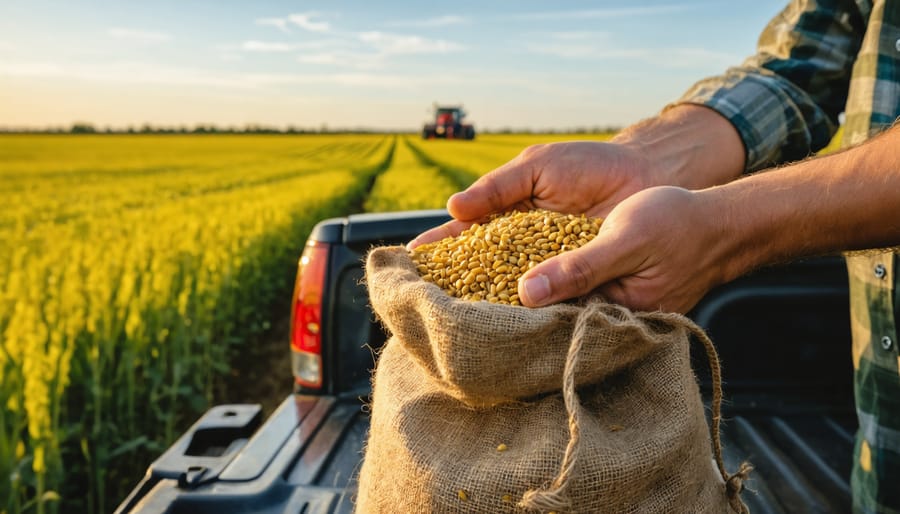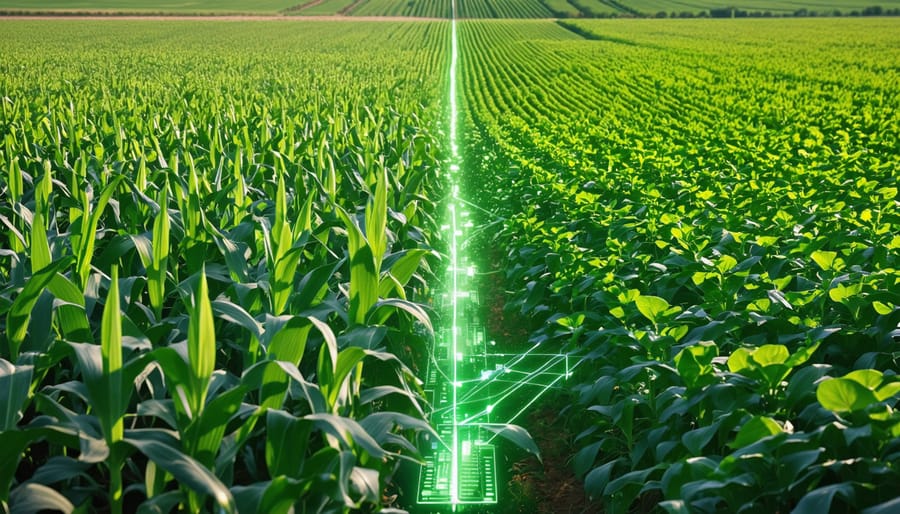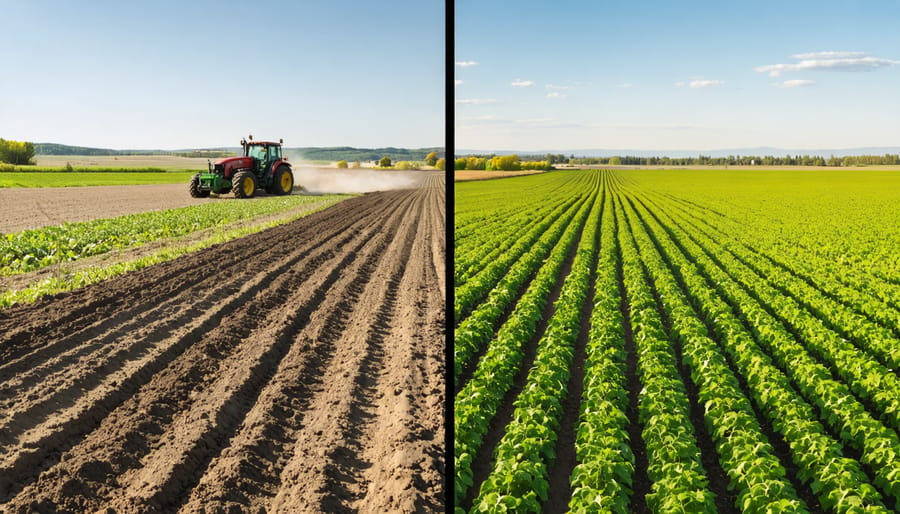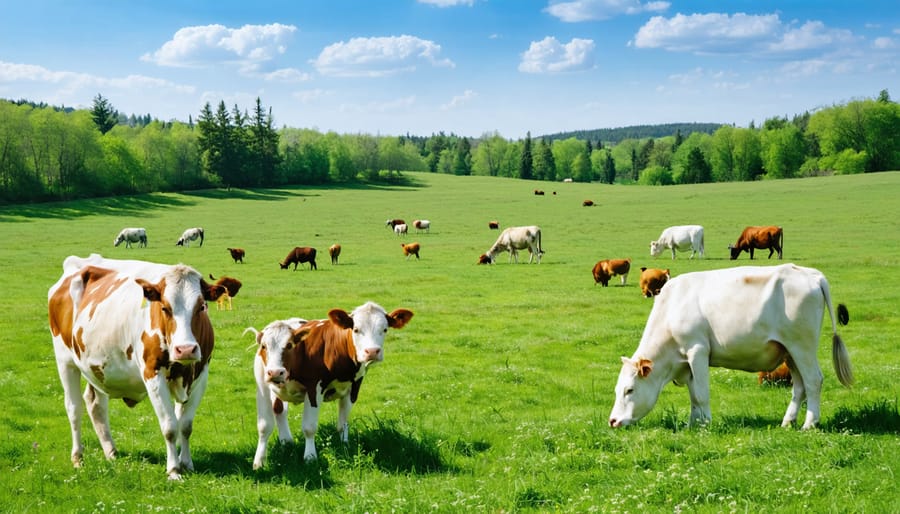Digital transformation revolutionizes agricultural operations by streamlining the organic certification process through integrated technology solutions. Alberta farmers implementing digital systems report 40% faster documentation processing and 60% reduced administrative burden within the first year of adoption.
Transform paper-based records into searchable digital archives using cloud-based platforms designed specifically for Canadian agricultural compliance. Connect field sensors, weather stations, and inventory systems to create a unified data ecosystem that automatically generates certification-ready reports. Implement blockchain technology to establish transparent, tamper-proof documentation trails that certification bodies increasingly prefer.
Modern digital tools eliminate data silos, enabling real-time collaboration between field workers, managers, and certifying agents. Mobile apps facilitate instant photo documentation, GPS-tagged field observations, and immediate updates to compliance records. This integration creates a robust digital infrastructure that adapts to evolving organic standards while maintaining the authenticity of traditional farming practices.
Success demands careful technology selection, thorough staff training, and commitment to data-driven decision-making. Start with core operational processes, establish clear metrics for success, and scale digital solutions based on demonstrated results.
The Digital Revolution in Organic Certification
From Paper Trails to Digital Records
The shift from traditional paper-based certification to digital records represents a significant milestone for Canadian farmers. Where filing cabinets once overflowed with hand-filled forms, inspection reports, and compliance documents, cloud-based systems now streamline these processes with remarkable efficiency.
Traditional certification methods typically involved maintaining physical copies of all documentation, including seed purchase receipts, field histories, and crop rotation plans. Farmers would spend countless hours organizing papers, making photocopies, and manually updating records. During inspections, certifying bodies would need to review stacks of paperwork, often requiring multiple visits to verify compliance.
Today’s digital certification platforms allow farmers to upload documents instantly, update records in real-time, and share information securely with certifying bodies. Mobile apps enable farmers to document field activities on the spot, complete with GPS coordinates and time stamps. Digital systems also provide automated reminders for important deadlines and compliance requirements, reducing the risk of oversight.
For Alberta farmers particularly, this transformation means less time managing paperwork and more time focusing on what matters most – growing quality organic crops and building sustainable farming operations.

Key Benefits for Alberta Farmers
Alberta farmers transitioning to digital certification processes gain significant advantages that streamline their operations and boost market competitiveness. The shift eliminates time-consuming paperwork, reducing administrative hours by up to 60% and allowing more focus on core farming activities. Digital record-keeping ensures all documentation is securely stored and easily accessible during audits, preventing costly delays or compliance issues.
The system enables real-time tracking of organic compliance requirements, sending automatic reminders for important deadlines and certification renewals. This proactive approach helps farmers maintain their organic status without interruption. Weather data integration and field mapping capabilities provide valuable insights for crop rotation planning and soil management decisions.
Digital platforms also facilitate faster communication with certifying bodies, cutting response times from weeks to days. Alberta farmers report spending 40% less time preparing for annual inspections when using digital systems. The technology creates transparent audit trails, making it easier to demonstrate compliance and build trust with buyers. Additionally, digital certification processes help farmers connect with other organic producers across the province, fostering knowledge sharing and community support.
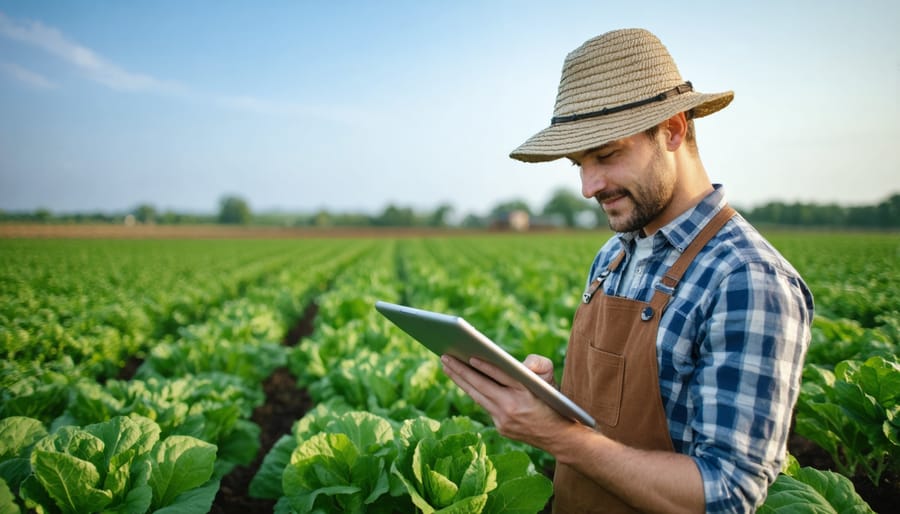
Implementation Steps for Your Farm
Assessment and Planning
Before embarking on your digital transformation journey, it’s essential to conduct a thorough assessment of your current farm operations and certification processes. Start by documenting your existing workflows, including how you currently track planting schedules, maintain records, and manage certification paperwork. This baseline understanding will help identify areas where digital solutions can make the most impact.
Consider forming a small team of key staff members who can contribute different perspectives on your operation’s needs. Remember that assistance for organic farmers is available through various provincial programs to help with this evaluation process.
Create a detailed inventory of your current technology infrastructure, including devices, internet connectivity, and any software you’re already using. This assessment should also consider your team’s digital literacy levels and training needs.
When planning your transformation:
– Set clear, achievable goals with specific timelines
– Prioritize changes based on potential impact and resource requirements
– Create a realistic budget that includes both initial investments and ongoing costs
– Develop a training schedule for staff members
– Establish metrics to measure success
Start small with pilot projects that can demonstrate quick wins. For example, begin by digitizing one aspect of your record-keeping system before tackling larger changes. This approach allows you to learn from experience and adjust your strategy as needed while maintaining your daily operations.
Tools and Technology Selection
When selecting digital tools for your farm’s transformation, it’s essential to start with a thorough assessment of your specific needs. Consider consulting with organic organizations in Canada for recommendations on approved certification management platforms that align with local standards.
Begin with basic digital infrastructure: reliable internet connectivity and sturdy devices that can withstand farm conditions. For documentation, choose cloud-based storage solutions like Google Drive or Microsoft OneDrive, which offer automatic backups and easy sharing capabilities.
Look for certification management software that includes:
– Mobile-friendly interfaces for field inspections
– Offline functionality for areas with poor connectivity
– Integration capabilities with existing farm management systems
– Multi-language support (English and French)
– Automated compliance checking features
Popular options among Alberta farmers include FarmersWeb for inventory management and Agrivi for comprehensive farm operations. For record-keeping specific to organic certification, platforms like MyFarm and COG Pro have proven effective for Canadian producers.
Remember to factor in training time and technical support availability when choosing your tools. Many software providers offer free trials – take advantage of these to ensure the platform meets your needs before making a long-term commitment. Start with one or two essential tools and gradually expand your digital toolkit as your team becomes more comfortable with the technology.
Staff Training and Adoption
Successfully implementing digital transformation requires a well-planned training approach that considers everyone on your farm team. Start by identifying digital champions within your operation – these are often younger team members who naturally gravitate toward technology and can help support others during the transition.
Create a structured learning environment by breaking down training into manageable segments. Begin with basic digital skills like using tablets for field documentation or accessing cloud-based record-keeping systems. Schedule training sessions during slower seasons, such as winter months, when team members have more time to focus on learning new skills.
Consider partnering with local agricultural colleges or extension services that offer digital literacy programs specifically designed for farm operations. Many Alberta-based institutions provide hands-on workshops where your team can practice with new technologies in a supportive environment.
Remember that adoption rates vary among staff members. Some might take to new systems quickly, while others need extra time and support. Maintain open communication channels and encourage questions. Create easy-to-follow reference guides that staff can access when needed, and consider implementing a buddy system where more tech-savvy team members can assist others.
Celebrate small wins and acknowledge progress to maintain motivation. Share success stories of how digital tools have made daily tasks easier or improved efficiency. This positive reinforcement helps build confidence and encourages continued engagement with new systems.
Real Success Stories
Small-Scale Success: The Turner Family Farm
Located just outside of Olds, Alberta, the Turner Family Farm’s journey to digital transformation began when third-generation farmer Sarah Turner noticed their paper-based organic certification process was consuming valuable time and resources. With 160 hectares of mixed crops and a growing direct-to-consumer business, the traditional method of maintaining certification records was becoming unsustainable.
In 2021, the Turners implemented a cloud-based certification management system, starting with a pilot program for their wheat fields. The system allowed them to input data directly from their mobile devices while in the field, automatically generating compliance reports and maintaining real-time records of crop rotations, inputs, and harvest data.
“The transition wasn’t without its challenges,” Sarah explains. “We spent about two weeks training our seasonal workers and family members on the new system. But once everyone got comfortable, we cut our documentation time by 70%.”
The digital system proved particularly valuable during their annual certification audit. Instead of sorting through paper files and spreadsheets, the Turners could instantly provide auditors with organized, complete records. The streamlined process reduced their audit preparation time from three weeks to just two days.
Today, the Turner Family Farm serves as a model for small-scale operations embracing digital transformation. Their success has inspired neighbouring farms to explore similar solutions, creating a ripple effect throughout the local farming community.
Large Operation Insights: Prairie Organic Cooperative
The Prairie Organic Cooperative, spanning 15,000 hectares across central Alberta, demonstrates how digital transformation can revolutionize large-scale organic farming operations. In 2021, the cooperative implemented a comprehensive digital management system that streamlined their certification processes and improved operational efficiency.
The cooperative’s transformation began with the adoption of a cloud-based farm management platform, allowing their 45 member farms to input and track field operations, crop rotations, and input applications in real-time. This system replaced traditional paper logbooks and spreadsheets, reducing documentation time by approximately 60%.
A key innovation was the implementation of blockchain technology for supply chain transparency. Each harvest is now tracked from field to market, with QR codes enabling customers to trace their produce back to specific farms. This enhancement has increased customer trust and commanded premium prices for their organic grains and pulses.
The cooperative also invested in IoT sensors across their properties, monitoring soil moisture, nutrient levels, and weather conditions. This data-driven approach has helped members optimize irrigation schedules and reduce water usage by 25% while maintaining crop yields.
Field Operations Manager Sarah Thompson notes, “The transition wasn’t without challenges, but we provided extensive training and peer support. Now, even our most tech-hesitant members appreciate how these tools have simplified their record-keeping and certification requirements.”
Overcoming Common Challenges
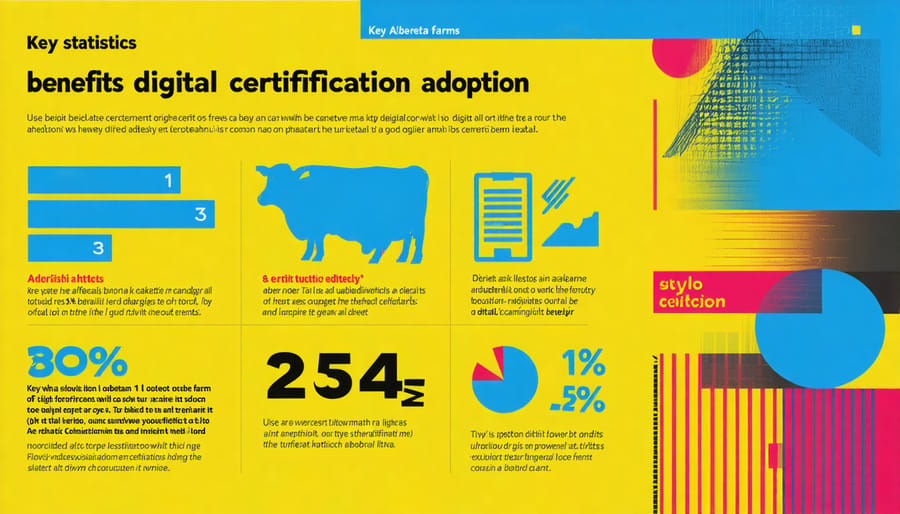
Technical Hurdles and Solutions
As farms begin their digital transformation journey, several common technical hurdles often arise. Poor internet connectivity in rural areas remains a significant challenge for many Alberta farmers. To address this, many operations are implementing hybrid systems that can work offline and sync data when connectivity is available. Local agricultural tech providers are also partnering with rural internet services to establish reliable connections through satellite and cellular networks.
Data security and privacy concerns represent another major challenge. Farmers can protect sensitive information by implementing strong password policies, using encrypted storage systems, and regularly backing up data to secure cloud services. Training staff on basic cybersecurity practices has proven essential for maintaining digital security.
System integration issues often emerge when combining legacy equipment with new digital tools. Many Alberta farmers have found success by starting with small, compatible systems and gradually expanding their digital infrastructure. Working with agricultural technology consultants who understand both traditional farming operations and modern digital solutions has helped smooth this transition.
Cost management remains a practical concern, but many farmers are addressing this through strategic implementation phases and by taking advantage of government digital transformation grants available to Canadian agricultural businesses.
Cost Management Strategies
Implementing digital transformation doesn’t have to break the bank. By exploring available cost management solutions, Alberta farmers can make this transition more affordable. Start by prioritizing essential digital tools and implementing them in phases rather than all at once. Consider joining forces with neighbouring farms to share subscription costs for software platforms, or participate in regional technology cooperatives.
Take advantage of government grants and agricultural technology incentives specifically designed for Canadian farmers. Many digital service providers offer scalable pricing models that allow you to start small and expand as needed. Training costs can be minimized by utilizing free online resources and workshops offered by agricultural extension services.
Consider open-source alternatives to expensive proprietary software where possible, and leverage cloud-based solutions that reduce the need for costly hardware investments. Remember to factor in long-term savings when calculating initial implementation costs – while some digital tools may seem expensive upfront, they often lead to significant operational cost reductions over time through improved efficiency and reduced manual labour requirements.
Digital transformation represents a significant opportunity for Canadian farmers to enhance their operations, improve efficiency, and stay competitive in an evolving agricultural landscape. As we’ve explored throughout this article, the journey to digitalization doesn’t need to be overwhelming or happen all at once. Start by identifying your farm’s most pressing needs and selecting technologies that directly address these challenges.
Remember that successful digital transformation is as much about people and processes as it is about technology. Engage your team early, invest in training, and create a culture that embraces innovation while respecting traditional farming wisdom. Consider starting with one or two key areas, such as precision agriculture tools or digital record-keeping systems, and build upon these successes.
Take advantage of available resources, including agricultural extension services, technology vendors, and fellow farmers who have already begun their digital journey. Many regional farming associations offer workshops and support networks to help you navigate this transition. Additionally, government programs and grants may be available to offset initial investments in digital technologies.
The future of Canadian agriculture is increasingly digital, but the pace of transformation is yours to set. Focus on sustainable, practical changes that make sense for your operation’s scale and goals. By taking measured steps toward digital adoption while maintaining your commitment to quality farming practices, you’ll be well-positioned to thrive in tomorrow’s agricultural landscape.


